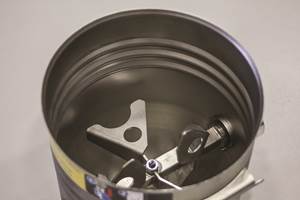Solving Feed-Related Surging
Understanding the causes of surging can help troubleshoot and correct it.
Surging or output variations have always been one of the major processing issues in single-screw extrusion. Melt pumps compensate by removing the output variation, but the surge behind the melt pump is still there. The changing speed of the screw reacting to the pressure behind the melt pump causes a continuous variation in screw speed. This in turn results in a continuous change in melt temperature and causes variations in die flow.
Sometimes changes in melt temperature can be corrected by a static mixer. But a surge is still an undesirable processing issue. Understanding the causes of surging can help troubleshoot and correct it.
Screw surging has four main causes, assuming the screw and temperature controls are working properly. They are feed-entry variations, polymer sticking to the screw, plugging of the melting section and an inadequately filled metering section. Let’s consider the feed-entry variation for the purposes of this column.
Feed-related variations can be caused by anything that interrupts or momentarily restricts the flow of polymer into the screw. This can be any mechanical device prior to the screw—such as a feeder—or the geometry of the flow passage the polymer follows to get to the screw. Also, the polymer bulk-flow characteristics can cause bridging or tunneling that result in erratic flow to the screw.
How do you recognize a feed-related surge versus the other types? Feed-related surges can be somewhat rhythmic or totally erratic, with a cycle varying from a few seconds to as much as several minutes, depending on what is causing them. However, a feed surge is always a momentary decrease in output—never an increase in output. The periodic decrease in polymer entering the screw tends to pass through the screw as a unit or “slug” without much redistribution, and exits as a momentary reduction in output.
Even when the amount of polymer in the screw changes for a very short time, the motor load is similarly affected. For example, if you have a 10% surge as measured by a 10% drop in head pressure, there will be a similar change in motor load for a similar time interval. Of course there will be a time delay between the observed change in motor load and the change in output or surge. The motor load decreases as the reduction in polymer in the screw flights passes through the screw, but it is not observed in the head pressure until it exits the screw.
In the “old days” this was easily observed by watching the drop in motor load and the drop in head pressure on the analog instruments, and noting they had very similar percentage changes as well as a similar cycle. If you still have analog meters and no melt pump, you have all the information you need to observe a feed surge.
With the broad use of melt pumps and digital instruments, it is hard, if not impossible, to determine such a pattern unless you are continuously plotting these functions. As a result most processors will need a data logger with several channels to troubleshoot the cause of surging. The plot of a feed-section surge without a melt pump would look somewhat like the accompanying illustration.
If you have a melt pump, you must produce this plot either under manual control of the pump speed or allow the extruder to drive the melt pump by turning the pump motor off and allowing the extruder to continue. Otherwise the drop in suction pressure behind the melt pump will cause the screw speed to change resulting in a motor-load change masking the whole thing. Surging is easily recognized with a melt pump, as you can see and hear the screw speed changing continuously, but you can’t tell what is causing it without some analysis.
Once you determine it is a feed surge, look in the area up to the feed section of the screw for the cause. If the surge does not follow the pattern shown then it is a result of one of the other causes of surging, which will be covered in another column.
Related Content
Five Quick Steps Toward Better Blending
Rising costs of resins and additives, along with higher demands for quality and use of regrind, place a premium on proficient blending. Here are some steps to get you there.
Read MorePlastics Technology Year in Review: Your Favorite Reads of 2024
A year-end review of the top stories showcasing industry trends, advancements and expert insights. Revisit the articles that captured the attention of the plastics community.
Read MoreICYMI: January Roundup
In case you missed it, here’s a short recap of the articles that our readers are taking note of.
Read MoreMedical Tubing: Use Simulation to Troubleshoot, Optimize Processing & Dies
Extrusion simulations can be useful in anticipating issues and running “what-if” scenarios to size extruders and design dies for extrusion projects. It should be used at early stages of any project to avoid trial and error and remaking tooling.
Read MoreRead Next
See Recyclers Close the Loop on Trade Show Production Scrap at NPE2024
A collaboration between show organizer PLASTICS, recycler CPR and size reduction experts WEIMA and Conair recovered and recycled all production scrap at NPE2024.
Read MoreMaking the Circular Economy a Reality
Driven by brand owner demands and new worldwide legislation, the entire supply chain is working toward the shift to circularity, with some evidence the circular economy has already begun.
Read MoreBeyond Prototypes: 8 Ways the Plastics Industry Is Using 3D Printing
Plastics processors are finding applications for 3D printing around the plant and across the supply chain. Here are 8 examples to look for at NPE2024.
Read More.jpg;width=70;height=70;mode=crop)












